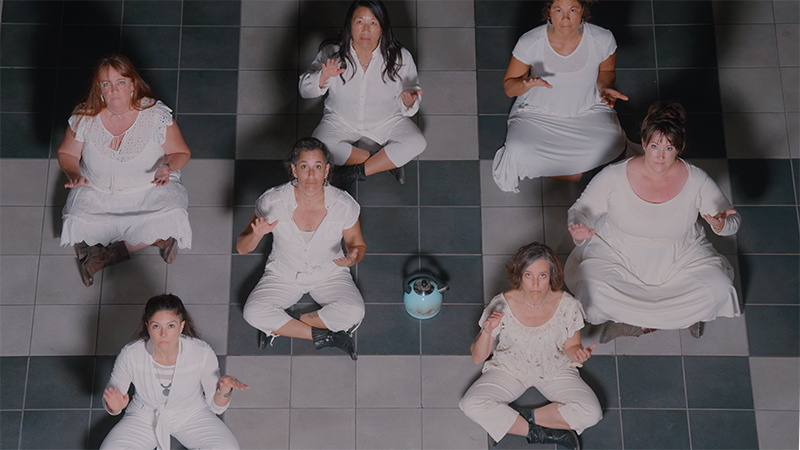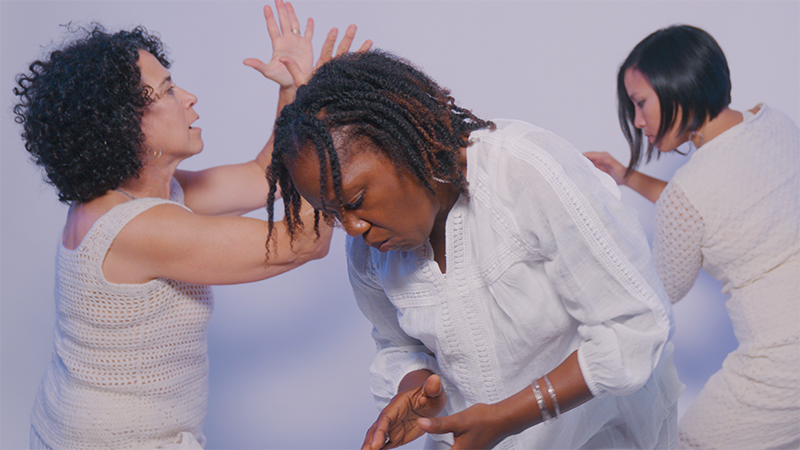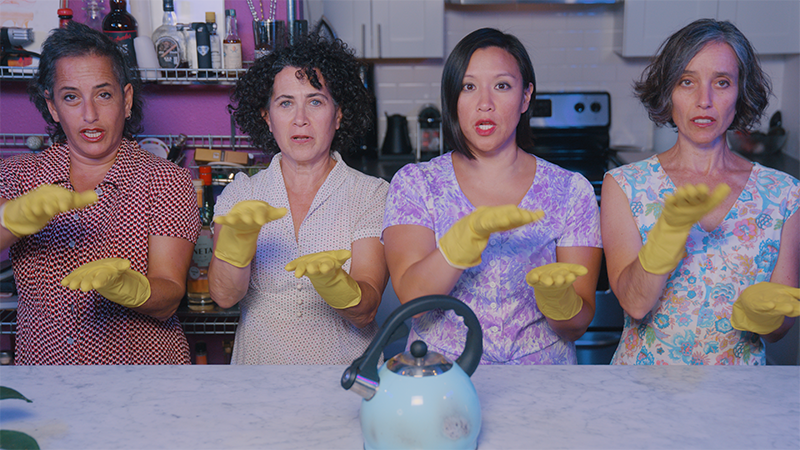Manifesting the Music and Stories of the Body
An Interview with Evie Ladin
BY EMMALY WIEDERHOLT
Photos by Dean Bosche/Outdoor Film
Evie Ladin is a body music choreographer based in the San Francisco Bay Area whose work integrates harmonic singing, body percussion, and rhythmic dance. As the artistic director of MoToR/dance, she is about to present her first full-length piece, Water in the Kettle, which combines Afrodiasporic polyrhythms with Appalachian folk singing to illuminate the maddeningly recurrent struggles of modern women. Here, Evie describes her path as a body music practitioner and how she’s looking at the ways feminist issues and US history sometimes mirror each other.
Water in the Kettle will be performed February 3 and 4, 2023 at Rhythmix Cultural Works in Alameda, CA.

~~
Can you share a little about your dance history and what shaped you as an artist?
My mother was an international folkdance teacher, and my dad was influenced by Appalachian music and dance traditions. My mom led folk dance groups, and my dad took our family to the earliest folk festivals. My sister and I got bit by Appalachian clogging, and whenever we crossed paths with anybody else doing percussive dance, we learned it. I grew up with this sense that dancing and playing music together is what people do. I spent my university education and the years following understanding that’s what most people do, but in Western culture, dancing and singing together is anomalous and somehow considered less important than in the rest of the world.
I was really bit by percussive dance and step dance. I was interested in rhythmic stuff as both dance and music. I also started playing banjo at a young age and singing with my sister. When I was 16, I was at Ashokan Fiddle and Dance camp, and we learned Ghanaian rhythms. A lightbulb went off; it made so much sense to me. I went to Brown for college, where I was cheeky enough to say I’ll accept the invitation if you let me in to the very competitive African drumming class. I managed to find some great mentors: Michelle Bach-Coulibaly had a beautiful mix of West African and contemporary dance that really spoke to me. There was an African faculty member, Anani Dzidienyo, who directed me in studying deeply about Africa in different departments. At Brown, students can create their own majors. Mine ended up being African Studies in Dance, and my thesis was about looking at cultures where music and dance are part of social communication. In Western culture, there’s this idea that people can’t dance, or they don’t understand it.
My senior year of college, I was hit by a car on my bicycle. I broke my leg badly, and it had a major impact on my trajectory and what I was able to do. When I graduated, I had a Fulbright to study in Nigeria. In my 20s, I joined a percussive dance company called Rhythm in Shoes. My other mentors, Sharon Leahy and Rick Good, were the artistic directors. Sharon was the choreographer, and she had an expansive view of how to present folk traditions in innovative ways. I toured nationally with them all through my 20s.
I was having trouble with articulation in the leg that was broken, including setbacks like my leg going numb. As a result, I was getting ready to leave the company. I was living in Bloomington, Indiana, and felt like I couldn’t do enough there artistically. I was going to move to Chicago, but the last project I did with Rhythm in Shoes was a six-month collaboration with Keith Terry and Crosspulse, a Bay Area company. We fell madly in love. He already had children on the West Coast, so I moved out to the Bay Area to be with him.
Within a couple months, I was teaching clogging, I was in my first band, the Stairwell Sisters, and I was doing a bunch of gigs with Crosspulse. Things fell into place. When I landed in the Bay Area, I did what I always have done in cities, which was check out all the dance spaces. Professionally, I consider myself a dancer first, mostly percussive dance and social dance. However, the dance scene in the Bay Area was much more avant garde, contemporary, and politically activist. I didn’t find a home there.
I was looking for percussive dance. I wanted to be part of a community that played music and danced together. When I came out to the Bay and worked with Keith’s group Crosspulse, I felt like I was able to reconnect with a lot of the things I grew up doing and things that interested me collaboratively across cultures.
Keith Terry and I started the International Body Music Festival in 2008 as a result of meeting a lot of people in the form and developing it as a genre. Keith Terry is most known for pioneering his own style of body music arising from his work as a jazz drummer with tap dancers. I noticed in the body music scene that it was mostly musicians putting music on their bodies, rather than dancers. There wasn’t a lot of choreography. I had a goal of doing polyrhythmic systems with hands, feet, and voice, moving in space. With MoToR/dance, I wanted to explore body music choreographically. In the process of putting polyrhythms on the body, I started layering Appalachian song on top of it. I was overtly reuniting African diaspora polyrhythms with Appalachian songs in a way that felt natural.
When participating in Appalachian music and dance, it’s important to understand the banjo is an African instrument. Spreading and understanding this history has been part of my mission since the get go. Appalachian culture is a mix of Black, brown, and white, and it is the first real cultural tradition created in this country. That mix created something new that has influenced so much music and dance that came after. People of color are starting to reclaim these Appalachian music traditions more widely. There is so much stereotyping around it, as well as a profoundly racist history, but also such rich art.

How would you describe body music choreography to someone unfamiliar with it?
The whole idea is we are creating our own soundtrack. The music we are making is as important as the shapes we’re making. It’s a skillset that’s pretty complex because you have to hold pitch and tone while you are moving. It involves breath control. Very often, dancers will move to a soundtrack, but they are not generating sound, so they don’t have to be as precise. In body music, precision is important. There’s also the range of sounds your body can make; in body music, you’re exploring all the sounds your body makes beyond clapping. The percussive sounds you’re making can be melodic and harmonic and can also involve the voice.
What was the impetus behind Water in the Kettle?
There was a piece called Water in the Kettle that my friend Lara Weaver wrote. Before I left Indiana, we produced a body music piece in a big show called The Feast. There was a movement and sonic sequence that stuck with me, and I’ve always wanted to recreate it.
A few years ago I brought Lara out West, and we talked about all the ways in which we put water on, exploring the metaphor. It’s a place of solace, a place of activism. So many cultures have a deep relationship with tea. It’s ceremonial. It’s a way people come together. There’s also the metaphor of water molecules bumping off each other in increasing intensity until it comes to a boiling point.
There’s an old song that asks “Watcha gonna do with the baby-o?”. The company is all women. Many of us were raised by feminist mothers, and we’re still coming up against similar struggles. Especially as we age, in the eyes of society we become less vital and visible. The larger work is the breach of promise of equality. At the end of the day, there’s still the question: Who’s going to take care of the baby?
In America, we built this country on the premise of freedom and equality, and yet on the backs of slavery and genocide. All this syncretic music and dance came out of this combination of cultures, and yet there are many breaches of promises. America, what are you going to do with the baby you created?
When I set out to do this, I thought I was doing a three-part 20-minute piece. Over the pandemic, I realized it’s an evening length show, which I have never done before on my own as a choreographer.
What has been your choreographic process for creating Water in the Kettle?
It often comes out of the rhythm and music. I put the music on the body and see how it makes me want to move and somatically interact. The skill of being able to play, dance, and sing all at once is complicated and takes a while to settle into the body. I have spent a lot of time creating vocabulary and going back and forth between the choreography and music, as well as tying it back to the themes.
After I graduated college, I spent a year as an intern at American Dance Festival looking at Black history in modern dance. I saw 18 contemporary dance shows that summer, the most I’d ever seen. I came to understand that in the world of contemporary dance, regardless of what it’s about, the most important question is: Does it move you or not? There’s a lot of conversation in contemporary art about what things are about. Coming from a traditional perspective, dances might represent certain things or exist for certain purposes, or they might not. The dances exist to do. I often feel trapped between more traditional ways of working with practice and contemporary ways of exploring themes. I have an issue in contemporary art, and especially in grant writing, where everything must be about something. Traditional ways of moving in community are thought of as less than, but in reality, they are foundational to human existence.
Do most of the performers in the piece come from a dance background or music background? What was the process making sure all the performers had the same body music skills?
It’s tricky finding people who are interested in the form and capable of doing it. At first, I accepted anyone who was interested and capable, but I realized I needed a more solid company. In January 2020, I held auditions. It’s not a typical dance company. There are people of different body sizes. Not everybody has a dance background. I was looking for people with the skills to explore music on their bodies and hold a tune and integrate it all into the space. It’s an unusual skillset.
Body music as an art form has taken off in in Europe and South America. People in the US think of Stomp, which is a great show, but I find it really aggressive. I wanted to explore the medium in a more complex feminine way. Because we are using our bodies in almost pedestrian ways (though quite multilayered), the audience feels drawn in. Because the work pulls from traditional sources, its very accessible and moving, and because it is a female company, we’re looking at the range of female experience, from very sensitive to very active and strong.
What do you hope audiences take away from Water in the Kettle?
I hope they feel empowered to create and participate in music and dance. I want them to have a range of emotions, to find things funny and appreciate the irony. Art is to be experienced, and you don’t need to know a lot about it to appreciate it and know if you like it or not. Art will either move you and you’ll find the depth in it, or it won’t. Of course, I hope it will move people through body music, and ideally to identify with the struggles we’re illuminating.

~~
To learn more, visit evieladin.com/projects/motor-dance.
